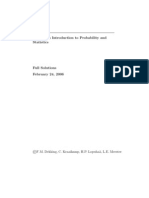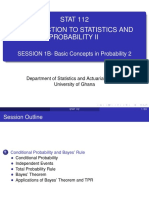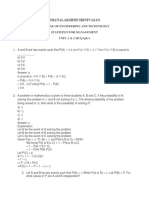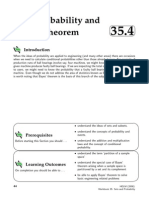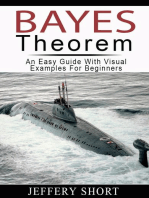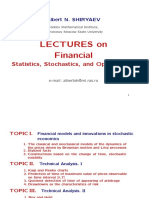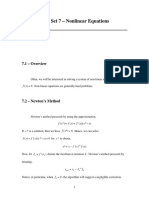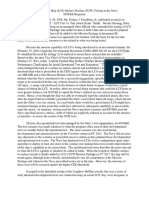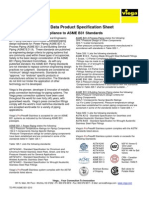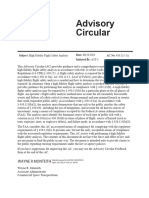®
Addition andMultiplication Lawsof Probability
35.3
Introduction
When we require the probability of two events occurring simultaneously or the probability of one orthe other or both of two events occurring then we need probability laws to carry out the calculations.For example, if a traffic management engineer looking at accident rates wishes to know the probabilitythat cyclists and motorcyclists are injured during a particular period in a city, he or she must takeinto account the fact that a cyclist and a motorcyclist might collide. (Both events can happensimultaneously.)
Prerequisites
Before starting this Section you should
...
•
understand the ideas of sets and subsets
•
understand the concepts of probability andevents
Learning Outcomes
On completion you should be able to
...
•
state and use the addition law of probability
•
define the term independent events
•
state and use the multiplication law of probability
•
understand and explain the concept of conditional probability
HELM (2008):Section 35.3: Addition and Multiplication Laws of Probability
29


1. The addition law
As we have already noted, the sample space
S
is the set of all possible outcomes of a given experiment.Certain events
A
and
B
are subsets of
S
. In the previous Section we defined what was meant byP
(
A
)
,
P
(
B
)
and their complements in the particular case in which the experiment had equally likelyoutcomes.Events, like sets, can be combined to produce new events.
•
A
∪
B
denotes the event that event
A
or event
B
(or both) occur when the experiment isperformed.
•
A
∩
B
denotes the event that both
A
and
B
occur together.In this Section we obtain expressions for determining the probabilities of these combined events,which are written P
(
A
∪
B
)
and P
(
A
∩
B
)
respectively.
Types of events
There are two types of events you will need to able to identify and work with: mutually exclusiveevents and independent events. (We deal with independent events in subsection 3.)
Mutually exclusive events
Mutually exclusive
events are events that by definition cannot happen together. For example, whentossing a coin, the events ‘head’ and ‘tail’ are mutually exclusive; when testing a switch ‘operate’and ‘fail’ are mutually exclusive; and when testing the tensile strength of a piece of wire, ‘hold’ and‘snap’ are mutually exclusive. In such cases, the probability of both events occurring together mustbe zero. Hence, using the usual set theory notation for events
A
and
B
, we may write:P
(
A
∩
B
) = 0
,
provided that
A
and
B
are mutually exclusive events
Task
Decide which of the following pairs of events (
A
and
B
) arising from the experi-ments described are mutually exclusive.(a) Two cards are drawn from a pack
A
=
{
a red card is drawn
}
B
=
{
a picture card is drawn
}
(b) The daily traffic accidents in Loughborough involving pedal cyclists andmotor cyclists are counted
A
=
{
three motor cyclists are injured in collisions with cars
}
B
=
{
one pedal cyclist is injured when hit by a bus
}
(c) A box contains 20 nuts. Some have a metric thread, some have aBritish Standard Fine (BSF) thread and some have a British StandardWhitworth (BSW) thread.
A
=
{
first nut picked out of the box is BSF
}
B
=
{
second nut picked out of the box is metric
}
30
HELM (2008):Workbook 35: Sets and Probability
®
Your solutionAnswer
(a)
A
and
B
are not mutually exclusive.(b)
A
and
B
are mutually exclusive.(c)
A
and
B
are not mutually exclusive.
Key Point 5
The Addition Law of Probability - Simple Case
If two events
A
and
B
are mutually exclusive thenP
(
A
∪
B
) =
P
(
A
) +
P
(
B
)
Key Point 6
The Addition Law of Probability - General Case
If two events are
A
and
B
thenP
(
A
∪
B
) =
P
(
A
) +
P
(
B
)
−
P
(
A
∩
B
)
If
A
∩
B
=
∅
, i.e.
A
and
B
are mutually exclusive, then P
(
A
∩
B
) =
P
(
∅
) = 0
, and this generalexpression reduces to the simpler case.This rule can be extended to three or more events, for example:P
(
A
∪
B
∪
C
) =
P
(
A
) +
P
(
B
) +
P
(
C
)
−
P
(
A
∩
B
)
−
P
(
A
∩
C
)
−
P
(
B
∩
C
) +
P
(
A
∩
B
∩
C
)
HELM (2008):Section 35.3: Addition and Multiplication Laws of Probability
31
Example 10
Consider a pack of 52 playing cards. A card is selected at random. What is theprobability that the card is
either
a diamond
or
a ten?
Solution
If
A
is the event
{
a diamond is selected
}
and
B
is the event
{
a ten is selected
}
then obviouslyP
(
A
) = 1352
and P
(
B
) = 452
. The intersection event
A
∩
B
consists of only one member - the tenof diamonds - which gets counted twice hence P
(
A
∩
B
) = 152
.Therefore P
(
A
∪
B
) = 1352 + 452
−
152 = 1652
.
Task
A bag contains 20 balls, 3 are coloured red, 6 are coloured green, 4 are colouredblue, 2 are coloured white and 5 are coloured yellow. One ball is selected atrandom. Find the probabilities of the following events.(a) the ball is either red or green(b) the ball is not blue(c) the ball is either red or white or blue. (Hint: consider the complementary event.)
Your solution32
HELM (2008):Workbook 35: Sets and Probability

















